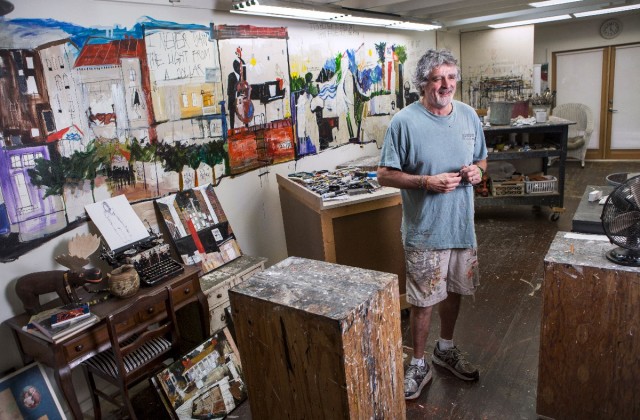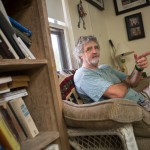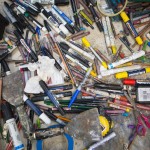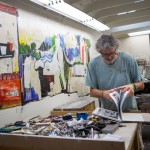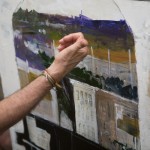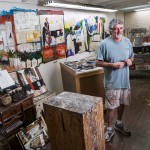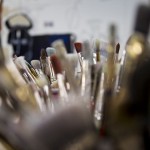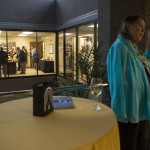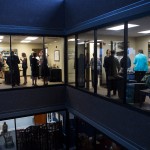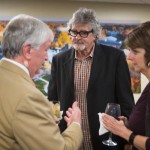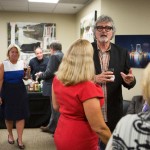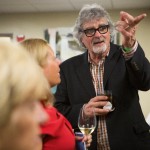The Storyteller
At the grand opening of Brenau’s Florida campus, Brenau President Ed Schrader announced that Dennis Campay, whose paintings appear there and elsewhere on Brenau campuses, had been appointed the university’s first Master Artist. Not bad for a guy who technically did not start working as a “professional artist” until he was 42.
In Jacksonville, Florida’s San Marco district, just across the St. John’s River from the central urban core of the city, the artist Dennis Campay works at the same table that he has used since he started his career in 1992 – or, to be more precise, since he started his current career.
The Portsmouth, Virginia, native was a bit of a late bloomer, by his description. He earlier kicked the tires on a number of endeavors, ranging from studying architecture at the University of New Mexico to the time he spent in Copperas Cove, Texas, barrel racing in rodeos on a horse named Cricket and wrangling steers on a cattle ranch – the polite term for branding and castrating 400-pound bull calves. He spent several years in Athens, Georgia, and then settled in Atlanta, where he took some courses at Georgia Tech while working at an architectural firm. He worked as an architectural designer for state government agencies, including the Georgia Bureau of Investigation and the Department of Family and Children’s Services, as he began perfecting his technique for freehand renderings and sketches. All of those former pursuits have found their way into his art.
By 1987, his work had attracted the attention of Lagerquist Gallery in Atlanta’s Buckhead district, which caters to emerging artists and designers in the region. That led to his return to school in 1989 to get a Bachelor of Fine Arts degree from Atlanta College of Art, which he completed in 1992. He was 42 years old.
“That is an age when people who really want to change careers and change their lives can do it,” says Campay, explaining his appreciation of Brenau’s outstanding record in offering educational opportunities to people, like him, who decide to go back to school later in life to change careers. “I am living proof that it can be done.… Of course,” he adds wryly, “I wouldn’t suggest that they become artists.”
That last part of the comment harks back to the days when he was just beginning his new career and, as he put it in an earlier interview, couldn’t afford to buy the really good paint. That lack of means forced him to improvise, which led to a discovery of one of his innovations: mixing cheaper paint with plaster, then hacking away at it with a paint scraper, which became a signature Campay technique.
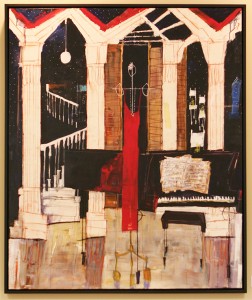
In his small studio on busy St. Augustine Road, Campay exemplifies the working artist. Tall, with glasses perched in his tousled salt-and-pepper hair, he wears paint-splattered shorts and T-shirt. Multicolored Sharpies and other markers, paintbrushes and putty knives lie scattered here and there like piles of pick-up sticks. Samples of his work, ranging from detail studies you might find in finished pieces to a large mural, mingle with other adornments, including a poster photograph of Pablo Picasso’s Guernica, the 1937 antiwar mural that is one of the Spanish artist’s best-known works.
Despite his late start, Campay has enjoyed considerable success with his unique style of expression.
His works are very, very visual – comprising distinct geometric lines and shapes, strong brush strokes and other marks that often reveal something of a picture within the picture. Although he confesses to a partiality to black-and-white drawing – dating back to his fondness as a kid for the work in MAD magazine – he uses color boldly, even when the colors are black and white.
His work has been displayed around the country in galleries and museums in New York, Charlotte, Denver, Atlanta, Jacksonville, San Francisco and Williamsburg, Virginia, to name a few. One of those, Shain Gallery in Charlotte, describes his work thus:
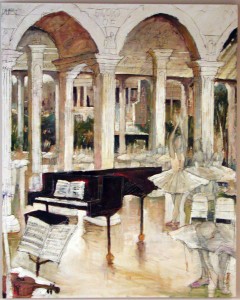
Dennis Campay’s paintings combine cosmopolitan cityscapes with an ethos that is at once rustic and sophisticated, conveying an international urbanity. His kaleidoscopic scenes present a mesmerizing mix of columns, porticos, slatted shutters, and balconies, gently coexisting with marshes, whitewashed churches, boats, and bridges. Silvery bodies of water, worn books, the solitary piano, and ubiquitous chairs take their place where interiors and exteriors blend and beckon, evoking memories, illusions and dreams.
His works are part of private and corporate collections around the United States, including those of Brenau University and the High Museum of Art in Atlanta. The university’s permanent collection includes Alpha & Omega, a large mixed-media piece on canvas in the main lobby of Brenau Downtown Center in Gainesville; two smaller works that are part of the Manhattan Gallery’s permanent installation; several black-and-white mixed-media drawings/prints/and large paintings located throughout the Trustee Library on the Gainesville historic campus; and The Bridge, 1997, a large painting representing the bridge school on display at the North Atlanta campus in Norcross, Georgia. When he learned that Brenau planned to exhibit pieces from its permanent art collection in the corridors and classrooms of its new campus in Jacksonville, Florida, Campay loaned several pieces from his personal collection for the effort.
And he remains a working artist.
“At this age, I don’t have any choice,” he says in his casually self-deprecating style. “I’m too old to start anything else.”
Yet, in a way, that is precisely what he is about to do. As a case in point, Campay has just published his first children’s book, The Magician’s Hat. Furthermore, he has just been appointed Brenau University’s first Master Artist, a position without portfolio, which – judging from his ideas for what it entails – he would love to see evolve into something more than ceremonial.
Campay and Brenau have enjoyed a relationship that dates back a couple of decades, at least, and he is a frequent visitor to the Gainesville campus and environs – both attending art exhibitions and presenting them. His 2011 artist talk to open his cityscapes exhibition at Brenau Galleries was one of the best attended in at least a decade.
For some time, however, he and Brenau President Ed Schrader have brainstormed various ideas for getting Campay more engaged with the school. From those discussions arose the idea for the Master Artist program. Different from a traditional “artist-in-residence” appointment that requires specific duties, like teaching classes on a regular basis, the Master Artist program will be “a formal recognition,” as Schrader explained the idea, “to enhance and increase the university’s relationship with creative people, like Dennis Campay, who are at the pinnacle of their careers.” Although there are no specific duties accompanying the designation, neither is any activity proscribed. It could involve occasional master classes or guest lectures for students and the public, mentorships for faculty as well as students or anything within the comfort levels of both the university and the artist.
“I cannot think of a better person than Dennis Campay to hold the title Brenau University Master Artist,” Schrader said. “He knows us and we know him.”
Campay agrees that he and Brenau are simpatico. As Brenau’s Master Artist, he says he wants to get more involved. For example, he believes Brenau’s enviable permanent art collection, although widely publicized, still remains “one of the best-kept secrets in the art world, and I’d like to be a part of getting the word out about it.” He also says he would be available for brainstorming with faculty and administrators about ongoing art education at the university, its goals for educating students and expanding art education beyond Gainesville. For example, he says he would like to see the university consider opening an art department at its new campus in Jacksonville, perhaps one that offers workshop-style programs. He envisions teaching professional courses “to artists who have kinda hit speed bumps in their careers and need something to get going again.”
In Campay’s view, education – for those who are just beginning or those who already have art careers going – should not overlook “the fundamentals.”
“It’s not about painting an apple,” he said. “It is about the process of painting an apple. You have to have something to focus on. As an artist, I am just moving paint around. If I want to make a tree, I can. If I want to make a building, I can. I don’t teach people to paint like Dennis Campay. I teach them to paint like themselves. It’s all fundamentals. You can copy Matisse or Picasso, and that’s OK – as long as you move it into what you do, use it in your art.”
In fact, Campay testifies to the efficacy and ethics of “the art” of borrowing from other artists.
“Always steal, but steal like an artist,” he says. “You borrow an idea, but use it in your own venue. I’m not going to invent anything new. Painting has been around forever.”
You see influences of his favorite painting, Guernica, in his work. And, just in case you are not familiar with them, he says his other influences include Benny Andrews, the Georgia-born sharecropper’s son who relocated to New York and, before his death in 2006, became one of the nation’s most important artists, noted for his expressionistic approach to themes of social injustice. Then there is Jacob Lawrence, who died in 2000, an African-American painter influenced by the shapes and colors of Harlem. In 1941, at 23, Lawrence gained national recognition – in part through publicity in Fortune magazine, of all places – with his 60-panel series, painted on cardboard, which depicted the great migration of African Americans from the rural South to the urban North. Campay also readily concedes that one of his idols, North Carolina–born and Harlem-raised Romare Bearden, borrowed from Edward Degas’ paintings of opera singers when he created memorable images of jazz great Billie Holiday. Campay paid homage to that borrowing when he borrowed from Bearden for his own work.
You will find images throughout Campay’s work that recur from painting to painting, drawing to drawing – architectural features like columns and church facades, images of signposts and marquees, a chair, a piano and – one of the artist’s favorites – an old typewriter that sits on a shelf in his studio. In his work, instead of a typewritten page, an image of some kind emerges from the typewriter’s roller.
“I am a storyteller,” he says. “My paintings are stories. Instead of words, visual literature comes out.”
- Dennis Campay at his studio in Jacksonville, Florida.
- Art supplies strewn about on one of Dennis Campay’s tables in his Jacksonville, Florida, studio.
- Dennis Campay at his studio in Jacksonville, Florida.
- Dennis Campay talks about texture in some of his paintings at his studio in Jacksonville, Florida.
- Dennis Campay stands in his Jacksonville, Florida, studio among a mural and art supplies.
- Paintbrushes in Dennis Campay’s Jacksonville, Florida, studio.
- Guests sample the food and enjoy Dennis Campay’s artwork at the opening of Brenau’s new Jacksonville campus.
- Brenau CFO David Barnett tours the new Jacksonville campus, with walls adorned with Dennis Campay’s artwork.
- Guests sample the food and enjoy Dennis Campay’s artwork at the opening of Brenau’s new Jacksonville campus.
- Guests sample the food and enjoy Dennis Campay’s artwork at the opening of Brenau’s new Jacksonville campus.
- Brenau’s Master Artist Dennis Campay speaks with Susan Davies and Ed Schrader during the open house for the new Jacksonville campus.
- Brenau’s Master Artist Dennis Campay speaks with trustee Parry Wolfe during the open house for the new Jacksonville campus.
- Brenau’s Master Artist Dennis Campay speaks with trustee Parry Wolfe during the open house for the new Jacksonville campus.
